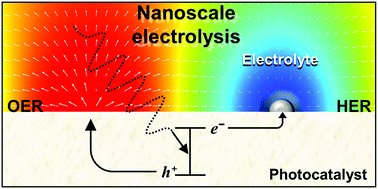当前位置:
X-MOL 学术
›
Sustain. Energy Fuels
›
论文详情
Our official English website, www.x-mol.net, welcomes your
feedback! (Note: you will need to create a separate account there.)
Contribution of electrolyte in nanoscale electrolysis of pure and buffered water by particulate photocatalysis†
Sustainable Energy & Fuels ( IF 5.0 ) Pub Date : 2018-06-29 00:00:00 , DOI: 10.1039/c8se00272j Muhammad Qureshi 1, 2, 3, 4, 5 , Angel T. Garcia-Esparza 6, 7, 8, 9, 10 , Tatsuya Shinagawa 1, 2, 3, 4, 5 , Philippe Sautet 11, 12, 13, 14, 15 , Tangui Le Bahers 6, 7, 8, 9, 10 , Kazuhiro Takanabe 1, 2, 3, 4, 5
Sustainable Energy & Fuels ( IF 5.0 ) Pub Date : 2018-06-29 00:00:00 , DOI: 10.1039/c8se00272j Muhammad Qureshi 1, 2, 3, 4, 5 , Angel T. Garcia-Esparza 6, 7, 8, 9, 10 , Tatsuya Shinagawa 1, 2, 3, 4, 5 , Philippe Sautet 11, 12, 13, 14, 15 , Tangui Le Bahers 6, 7, 8, 9, 10 , Kazuhiro Takanabe 1, 2, 3, 4, 5
Affiliation

|
Photocatalysis using semiconductor powders in suspension performs reduction and oxidation reactions at nanometer-scale distances. Such short distances between the reduction (cathode) and the oxidation (anode) sites enable photocatalytic water splitting to generate H2 and O2 from pure water without a supporting electrolyte, which is otherwise impossible in conventional electrode systems due to the high solution resistance. A CrOx/Pt/SrTiO3 model photocatalyst achieves high efficiency under UV irradiation in ultra-pure water splitting at rates (>1 μmol-H2 per cm2 per h) corresponding to electrocatalysis on the order of mA cm−2. The introduction of an unbuffered supporting electrolyte did not improve the photocatalytic rates, consistent with the negligible ohmic losses (<1 mV) numerically calculated using the Poisson–Nernst–Planck equations. The Nernstian potential loss resulting from pH gradients became apparent at high photocatalytic rates (>100 mV when rate >1 μmol-H2 per cm2 per h) even when the distance between redox sites was below 10 nm. Substantial improvements in photocatalytic rates were observed when buffer ions were introduced into near-neutral pH media by not only circumventing pH gradients but introducing kinetically facile H+ reduction to H2 instead of the kinetically sluggish direct reduction of H2O to H2. Herein, the quantitative descriptions of the electric potential, concentration gradients, and catalytic performance in nanoscale water electrolysis are presented with emphasis on (1) the advantages of performing redox reactions at the nanoscale, (2) the use of electrolyte engineering at near-neutral pH as a universal and effective strategy, and (3) the effectiveness of transferring knowledge from electrocatalysis to photocatalysis, where the potential is quantitatively defined regarding the former and poorly quantified regarding the latter.
中文翻译:

电解质在颗粒光催化纳米级纯水和缓冲水电解中的贡献†
在悬浮液中使用半导体粉末的光催化在纳米级距离上进行还原和氧化反应。还原(阴极)和氧化(阳极)位点之间的这种短距离使得光催化水分裂能够从没有支持电解质的纯净水中产生H 2和O 2,否则由于高溶液电阻而在常规电极系统中是不可能的。甲的CrO X /铂/的SrTiO 3模型的光催化剂达到的速率在UV照射下高效率在超纯水分裂(> 1微摩尔-H 2每厘米2每小时),对应于电催化毫安厘米的量级上-2。引入无缓冲支持电解质并不能提高光催化速率,这与使用Poisson-Nernst-Planck方程计算得出的可忽略的欧姆损耗(<1 mV)一致。从pH梯度导致的能斯特电势损失在高的光催化速率变得明显(> 100毫伏时率> 1个微摩尔-H 2每厘米2每小时),甚至当氧化还原位点之间的距离为低于10nm。当不仅通过避开pH梯度,而且通过将动力学上容易的H +还原为H 2而不是将动力学上缓慢的H 2 O还原为H引入缓冲离子到近中性pH介质中时,可以观察到光催化速率的显着提高。2。在此,对纳米级水电解中的电势,浓度梯度和催化性能的定量描述以以下方面为重点:(1)在纳米级进行氧化还原反应的优势;(2)在接近中性的条件下使用电解质工程技术pH是一种普遍有效的策略,并且(3)将知识从电催化转移到光催化的有效性,其中,前者的潜力是定量定义的,而后者则是量化不佳的。
更新日期:2018-06-29
中文翻译:

电解质在颗粒光催化纳米级纯水和缓冲水电解中的贡献†
在悬浮液中使用半导体粉末的光催化在纳米级距离上进行还原和氧化反应。还原(阴极)和氧化(阳极)位点之间的这种短距离使得光催化水分裂能够从没有支持电解质的纯净水中产生H 2和O 2,否则由于高溶液电阻而在常规电极系统中是不可能的。甲的CrO X /铂/的SrTiO 3模型的光催化剂达到的速率在UV照射下高效率在超纯水分裂(> 1微摩尔-H 2每厘米2每小时),对应于电催化毫安厘米的量级上-2。引入无缓冲支持电解质并不能提高光催化速率,这与使用Poisson-Nernst-Planck方程计算得出的可忽略的欧姆损耗(<1 mV)一致。从pH梯度导致的能斯特电势损失在高的光催化速率变得明显(> 100毫伏时率> 1个微摩尔-H 2每厘米2每小时),甚至当氧化还原位点之间的距离为低于10nm。当不仅通过避开pH梯度,而且通过将动力学上容易的H +还原为H 2而不是将动力学上缓慢的H 2 O还原为H引入缓冲离子到近中性pH介质中时,可以观察到光催化速率的显着提高。2。在此,对纳米级水电解中的电势,浓度梯度和催化性能的定量描述以以下方面为重点:(1)在纳米级进行氧化还原反应的优势;(2)在接近中性的条件下使用电解质工程技术pH是一种普遍有效的策略,并且(3)将知识从电催化转移到光催化的有效性,其中,前者的潜力是定量定义的,而后者则是量化不佳的。











































 京公网安备 11010802027423号
京公网安备 11010802027423号